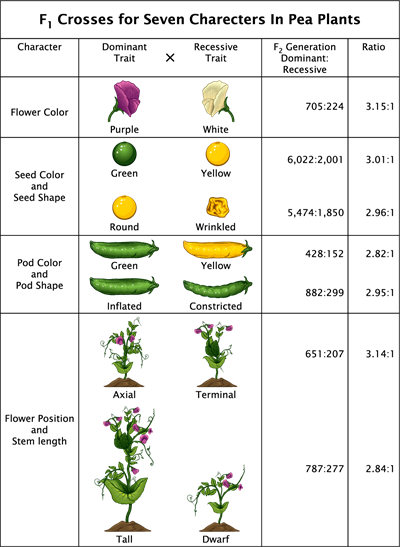PDF chapter test TRY NOW

\(F1\) crosses for seven characters in pea plants and their results in \(F2\) generations
To study the laws of heredity, Gregor Mendel chose the pea plant as the primary model system for his experiments. He chose seven contrasting characters of a pea plant. The above table depicts the results of Mendel's experiments in \(F1\) crosses of the seven characters.
For example,
"Consider the first row of the table."
The first row of the table indicates the crossing or self-pollination of \(F1\) generation pea plants concerning their character - flower colour. This crossing involves purple-flowered pea plants and white-flowered pea plants.
In the second column, dominant trait and recessive trait are mentioned. Since all the flowers of the \(F1\) generation pea plants have purple coloured flowers, Mendel concluded that the purple colour of the flower is the dominant trait and the white colour of the flower is the recessive trait.
Mendel did self-pollination of the \(F1\) generation plants and collected seeds from them. These seeds are \(F2\) hybrid seeds, and he grew \(929\) plants with these seeds. These plants are called \(F2\) generation plants.
In these \(F2\) plants, he found out \(705\) plants have purple coloured flowers (dominant character), and \(224\) plants have white coloured flowers (recessive character), which is mentioned in the third column of the table as \(F2\) dominant vs recessive.
Thus, the ratio between the number of dominant and recessive plants in \(F2\) generation is \(705:\)\(224\). This ratio can further be reduced to \(3.15:\)\(1\), which is mentioned in the fourth column of the table.
Mendel discovered that the number of plants with dominant and recessive characters in the \(F2\) generation is approximately equal to \(3:\)\(1\).
The above example is for the character flower colour.
Similarly, Mendel did monohybrid crosses and studied remaining pea plant traits, such as seed shape, seed colour, plant length, pod shape, pod colour, and the pod's position.
The respective results of the \(F1\) crossing experiments are tabulated in the table.
From the results mentioned in the table, we can see that, in the \(F2\) generation, irrespective of the trait or character, the ratio of a number of plants with dominant and recessive characters is always approximately equal to \(3:\)\(1\).
Differences between a monohybrid and dihybrid cross:
Monohybrid cross | Dihybrid cross |
A monohybrid experiment is a genetic cross between two homozygous individuals with different alleles for the same gene locus of interest. | A dihybrid experiment is a genetic cross between individuals who hold different alleles for two different gene loci of interest. |
One character is considered and studied in a monohybrid cross. | Two independent characters are considered and studied in a dihybrid cross. |
A single pair of genes are involved. | There are two pairs of genes involved. |
The monohybrid cross has a phenotypic ratio of \(3\)\(:\)\(1\). | The dihybrid cross has a phenotypic ratio of \(9\)\(:\)\(3\)\(:\)\(3\)\(:\)\(1\). |
In a monohybrid cross, the genotypic ratio of \(F2\) generation is \(1\)\(:\)\(2\)\(:\)\(1\). | In a dihybrid cross, the genotypic ratio of \(F2\) generation is \(1\)\(:\)\(2\)\(:\)\(2\)\(:\)\(4\)\(:\)\(1\)\(:\)\(2\)\(:\)\(1\)\(:\)\(2\)\(:\)\(1\). |
The monohybrid cross is essential to determine the allele dominance relationship. | Dihybrid crosses are essential for determining the independent assortment or distribution of alleles. |
Difference between Mendel's laws:
Law of dominance | Law of segregation | Law of independent assortment |
"When two homozygous individuals with one or more sets of contrasting characters are crossed, the characters that emerge in the \(F1\) hybrid are dominant, while the ones that are not present in the \(F1\) hybrid are recessive." | "An \(F1\) hybrid is created when two contrasting factors are combined. When gametes are created, the two components of the allelic pair stay together without mixing, and only one penetrates each gamete." | "When two or more pairs of characters are inherited at the same time, the factors or genes of one pair sort out independently of the other pair." |
| The law of dominance is formulated based on the monohybrid experiment. | The Law of segregation is also formulated based on the monohybrid experiment. | The Law of independent assortment is formulated based on the dihybrid experiment. |
Reference:
https://www.shutterstock.com/image-vector/mendel-genetic-concept-crossing-seven-characters-1462068644
